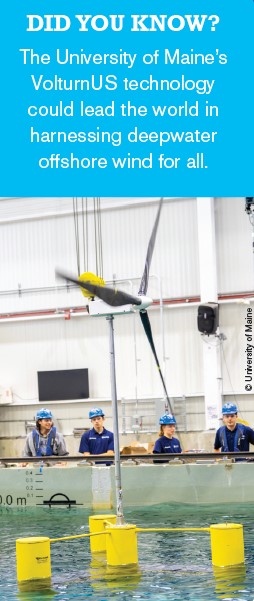OFFSHORE WIND for ME: Reliable Clean Energy from Sea to Shore
Climate change is the greatest threat facing the wildlife, outdoor spaces, and coastlines we all cherish as Mainers. We already have the technologies needed to avoid the worst — but we must act now to move rapidly away from expensive and unreliable oil and gas.
Responsibly developing offshore wind in the Gulf of Maine will provide the large amounts of home-grown energy we need to power the future:
- Reliable: The Gulf of Maine has some of the strongest and most consistent winds in the world.
- Affordable: The energy produced by large wind projects will bring down wholesale energy prices and make Maine less dependent on expensive oil and gas.
- Clean: Offshore wind will reduce pollution and is an essential tool for meeting Maine’s goal of 100% clean energy by 2040, while creating thousands of good-paying jobs for Maine people.
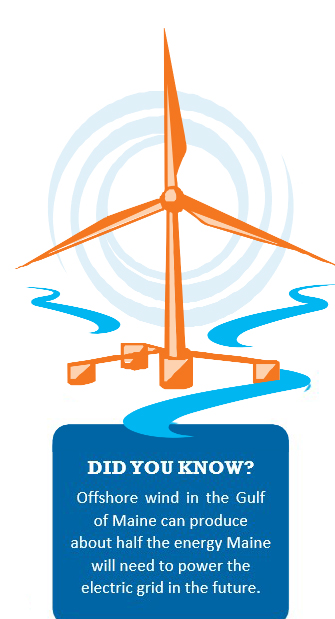
Responsible Development: Leading the Nation in Floating Offshore Wind
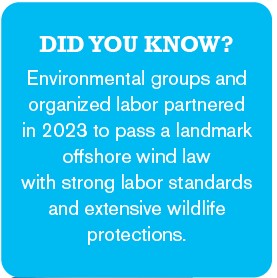 Using the best data and scientific research available, offshore wind projects in the Gulf of Maine will be held to the highest standards for siting and operations to protect wildlife, ecosystems, and existing ocean users.
Using the best data and scientific research available, offshore wind projects in the Gulf of Maine will be held to the highest standards for siting and operations to protect wildlife, ecosystems, and existing ocean users.
- Protecting Wildlife: Climate change is the greatest threat facing the more than 3,000 marine species and birds in the Gulf of Developers will be required to include strong protections for wildlife and the ocean environment for both construction and operations.
- Supporting Coastal Communities: Maine’s offshore wind law encourages plans for investments and benefits agreements in coastal communities. The areas proposed for commercial offshore wind projects are outside the fishing areas used by nearly the entire Maine-based lobster fishery.
- Generating Economic Development: An offshore wind industry for Maine will bring hundreds of millions of dollars in investments from the federal government and private companies, creating life- long careers for our youth, providing new opportunities for Maine businesses, and growing Maine’s economy.
Maine-Made Energy: Creating New Jobs and Economic Growth
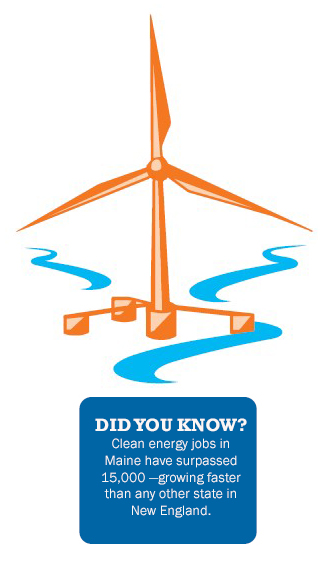 Maine’s proud ship-building and maritime history perfectly position our state to lead the world in floating offshore wind technology, bringing good-paying jobs and long-lasting careers to Maine people.
Maine’s proud ship-building and maritime history perfectly position our state to lead the world in floating offshore wind technology, bringing good-paying jobs and long-lasting careers to Maine people.
More than a decade of innovative research from scientists at the University of Maine has positioned Maine at the forefront of floating wind turbine technology.
- 100+ new occupations will be a part of Maine’s new offshore wind industry, from engineering and planning, to biologists, legal and business support, and construction and maritime occupations.
- Tens of thousands of jobs could be created once Maine develops an offshore wind port and associated supply chain businesses, according to estimates developed for Maine’s Offshore Wind Roadmap.
A World-Class Wind Port
To achieve this vision of powering our future with clean, reliable offshore wind, we need to build a world-class port in Maine to construct the floating wind turbines that will be used.
- In February of 2024, Sears Island was announced as the State’s preferred site for the offshore wind port, after significant stakeholder engagement and environmental and economic analysis. The port will be developed on land owned by the Maine Department of Transportation.
- Developing port infrastructure is essential to launching offshore wind projects at scale. It is also the best way to capture the local union job and economic benefits of the industry while showcasing the University of Maine’s leading floating turbine technology.
- With deep water access to the port development site, Maine has the potential to establish a premier location for the industry and help meet growing demand in the U.S. for offshore wind port infrastructure.
Innovative Clean Energy Technology
Innovative Technology Developed Here in Maine
Over more than a decade, the students and researchers at the University of Maine’s Advanced Structures and Composites Center have pioneered patented semi- submersible floating offshore wind platform technology. This innovative research will help catalyze offshore wind technology development and deployment; create opportunities for the U.S. supply chain; and advance engineering and design, financing, manufacturing, and installation to reduce costs and research the interaction of offshore wind projects with fishing, wildlife, and the ecosystem.
How Offshore Wind Energy Will Work
The Gulf of Maine includes a vast area of about 36,000 square miles, and most of it is in federal waters. Because ocean waters off Maine’s coast become deep very quickly, it is not possible to build projects directly on the sea floor. Offshore wind turbines will be placed on floating platforms anchored to the sea floor.
- The Gulf of Maine is a shared public resource, and everyone who uses it, including fishermen and lobstermen, must have a voice in how this resource contributes to Maine’s future needs.
- The federal government has already designated areas far offshore in the Gulf of Maine where floating wind projects will be developed. These sites were identified after extensive input over several years to avoid conflicts with lobstermen, traditional fishing grounds, protected natural resources, and other uses of the ocean.
- Developers will bid on federal leases to build wind projects that produce clean energy that can be used to meet rising electricity demand and achieve Maine’s climate Project considerations that will be evaluated in the bids will include energy prices, wildlife protection, and community benefits among others.
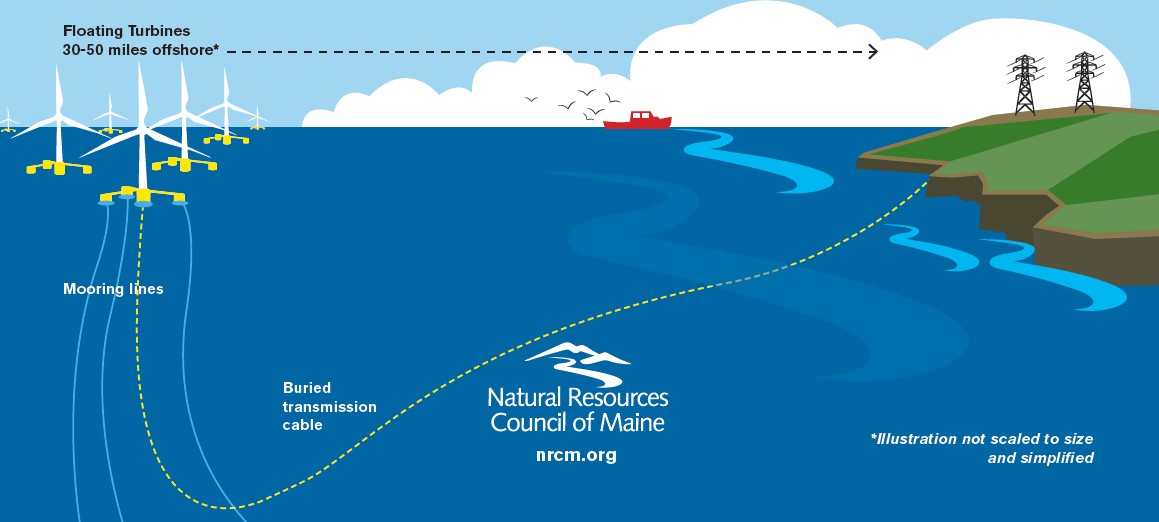
Banner photo by JShapiro/NRCM








